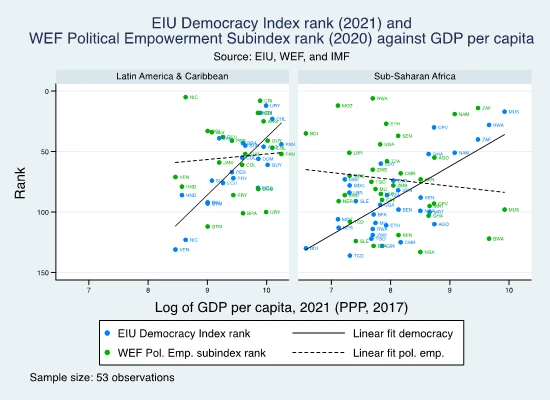 Image: Yindee, Shutterstock
Image: Yindee, Shutterstock
The quality of governance affects how a country grows and develops and how its citizens, both men and women, benefit from that growth. However, existing indicators of governance mostly do not distinguish how different groups in society experience it, for example, they do not explicitly treat gender differences. Any indicator that claims to measure the quality of governance but fails to account for systematic differences in how distinct groups are treated, may be missing an important quality of governance. Do countries that we consider well-governed today treat their women well? And do we have information to answer this question?
Governance is a tricky concept being composed of distinct, hard to measure parts. A government’s economic performance, as evidenced for example, by how well it manages fiscal budgets, or how much integrity the public sector exhibits, as evidenced by measures of corruption, are two such parts. But the degree of political stability or law and order or voice given to citizens are equally measures of governance. As examples, in managing fiscal budgets, governments may get good scores but may do so while they penalize women more than men in their fiscal choices; or, in the political process, they may give less voice to women relative to men, or formal law and order processes may be more punishing to women in their implementation. Women, who account for half of the population, may thus face a systematically different quality of governance, particularly in some of its attributes, from men. Maybe, our view of which country governs better, and the indicators we use, need to explicitly take these differences into account.
Let us consider the EIU Democracy index for illustrative purposes. This index consists of 60 different subcomponents in the following categories: electoral process and pluralism, functioning of government, political participation, democratic political culture and civil liberties; yet only one question asks specifically about gender differences and one other combines gender and other factors. Comparing the EIU’s Democracy Index and the World Economic Forum’s women’s political empowerment score, over 50% of the countries find their rankings worsen along the gender indicator, relative to their position on the governance indicator (a similar dynamic is found for other indicators, such as WEF’s Economic Participation and Opportunity index) and most others move in the opposite direction. In other words, rankings are not related in the two indicators. More important, at least 30% of the countries in the sample move at least 2 quintiles in the rankings compared together- a large change. Countries that do relatively well on governance, do not necessarily do as well, relative to others in the same group, on gender.
"The quality of governance affects how a country grows and develops and how its citizens, both men and women, benefit from that growth"
A question is whether indicators measuring gender equality also improve consistently with income. Figure 1 shows the same index rankings plotted against GDP per capita. As might be expected, countries with higher per capita income also tend to be ranked higher relative to comparators on both governance and gender equality indicators. However, the gender equality rankings do not show as strong a positive correlation with GDP per capita as do governance indicators, no matter which sets of governance and gender gap indicators are considered. Interestingly, several lower income countries, ranked relatively low on governance, have much higher placement along the gender index. The difference in slopes illustrated in Figure 1 is statistically significant at the 1% confidence interval.
Figure 1: Rankings on EIU Democracy Index and WEF Political Empowerment Indices against GDP per capita

These variations in women’s empowerment relative to a country’s governance quality, show up more strongly when we look at clusters of countries, specifically regional clusters. Figure 2 below highlights the different patterns that governance quality and gender equality rankings follow in Latin America and the Caribbean and Sub-Saharan Africa when plotted against GDP per capita.
Figure 2: Gender and governance indicators against GDP per capita in Latin America and the Caribbean and Sub-Saharan Africa.

While in Latin America and the Caribbean women’s political empowerment seems to be far less positively correlated than democracy to GDP per capita, in Sub-Saharan Africa these two indicators seem to be strikingly divergent. Perhaps we can learn something from these patterns.
A rough “gender-corrected” governance indicator that gives more weight to women’s concerns might be composed by combining the uncorrected governance indicators (here the democracy index) and gender equality indicators (such as women’s participation in the political process). One way to do this might be to take some weighted measure; this can be done, for example, by multiplying the governance and gender indicators or adding them (to get weighted or unweighted averages). A better way would be to include explicit gender-related measures to the construction of any governance indicator.
Given the pandemic’s uneven effect on women and men across countries (e.g., Dang and Nguyen, 2021), and the potential impact of the continuing global crisis – it is even more important to consider how a country’s governance and institutional framework reflects gender concerns. Moreover, what we see in terms of gender equality, can reasonably be expected to hold for minorities of different types. But we need more. To see how improved (gender-corrected) governance may affect gender gaps, there needs to be more gender- disaggregated data. There are so many places where this is imperative: health, access to transport services, agriculture, and access to finance to name a few. Maybe with more attention directed to these discrepancies, there will be less fragility and more sustainable development.
It is sobering to know that it was only in 1993 that the US Congress wrote in law an inclusion policy for the National Institutes of Health that required representation of women and minorities in clinical research. As the saying goes, “better late than never”.



Join the Conversation